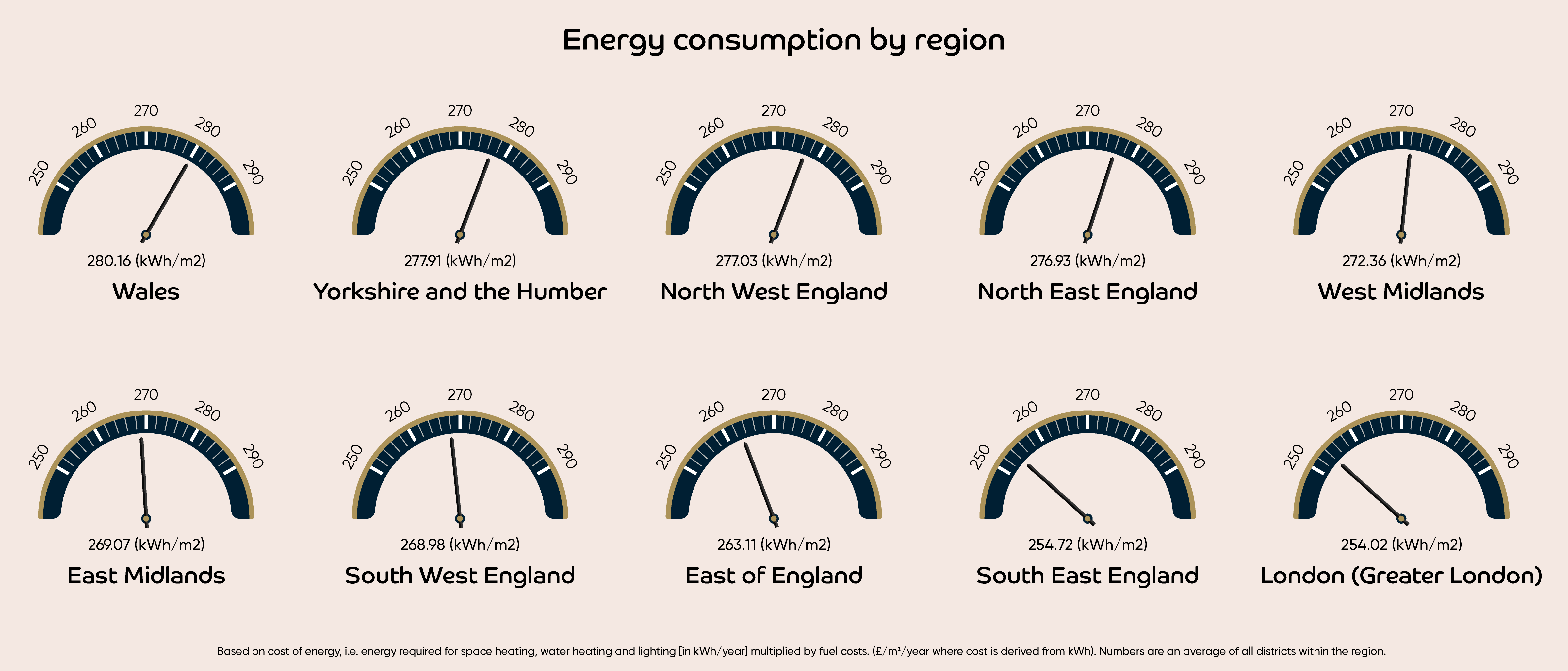
How energy efficient is housing in the UK?
As autumn sweeps in, with crunchy leaves and wet weather in tow, we are once more reminded that winter and higher energy bills aren’t too far away. In the winter of 2021, energy bill prices are expected to soar more than usual due to a number of different factors affecting the energy industry. In light of the UK energy crisis, we wanted to find out how Brits are spending their money when it comes to energy bills and where the best, and worst, places to live in terms of energy consumption and home efficiency are. We looked into the following factors:- How much homes are spending on their energy bills
- EPC ratings of homes from across the UK
- The environmental impact that homes are having
- The energy consumption levels from households across the UK
- Amounts of CO2 emitted from homes in the UK
The UK’s EPC Ratings
The first thing we looked at was the average UK EPC ratings by region. ‘EPC’ stands for Energy Performance Certificate and is a rating given to homes and properties to help describe how efficient homes are by taking into account the building materials used, the heating systems, and insulation. An EPC gives a property a rating from A (most efficient) to G (least efficient) with the aim to highlight how expensive it will be to power or heat a property as well as point out how much room for improvement there is. On average, homes with lower EPC ratings pay more for their heating and energy. With a little more clarity regarding EPCs out of the way, what do the average ECP ratings across the UK look like? 
Firstly, it’s important to note that the target band rating for the country is currently an E (39-54 points) with an initiative pushing landlords and homeowners to get it to a C by 2025. At the moment, all regions in the UK currently sit in band D (55-68 points) with some regions edging closer to the target band than others. Interestingly, Greater London has the highest average EPC rating out of all UK regions, so while the property prices are among some of the highest in the country, those living in the capital pay some of the lowest energy bills - a great perk! On the flip side, Wales has the lowest average EPC rating out of all regions. But there is a good reason for the western regions having less-than-good heat retention. Most properties along the western fringes of the country are very old and aren’t suitable for modern insulation methods, such as cavity wall insulation, due to being exposed to more wind and driven rain, which can cause mould issues. Cavity wall insulation is a type of heat retention technology that fills the gap between the inner and outer walls of your home with insulating material - retaining heat and reflecting it back into your home.
How much energy are homes in the UK consuming?
Knowing what we do about average EPC ratings, it’s not surprising to see the results on energy consumption levels. By energy consumption, we include the energy used for heating, hot water, and lighting. 
Homes in Wales consume more energy than homes in any other UK region - not surprising considering they are also the least efficient at retaining heat in the country. London, on the other hand, boasts some of the lowest energy consumption rates in the country. In fact, by moving from Wales to Greater London, you could cut your yearly energy consumption by over 26%.
How much are we spending on our energy bills?
It will probably come as no surprise to hear that energy bill prices are directly affected by the rates of energy consumption and efficiency ratings. Homes that use a greater amount of energy to run and heat will cost more than homes that retain warmth better.

Wales and Grater London are once again at opposite ends of the comparison. Residents of Greater London pay the least for their annual energy bills on average thanks to the better efficiency and lower energy consumption. At the top of the list, Wales tends to pay the most for their bills annually. By moving from Wales to Greater London you could save:
- An average of £248.32 on heating per year
- About £11.62 on your annual lighting bills
- Around £25.19 on your annual hot water bills
Where is energy consumption having the biggest environmental impact?
Along with potentially higher energy consumption as well as higher bills, less efficient homes can also have a bigger impact on the environment. CO2 emissions can be attributed to the amount of energy used to heat and light your home, personal vehicle use, as well as electricity used to power appliances and other electrical items.

It’s therefore unsurprising that households in Wales have the biggest environmental impact producing an average of 4.79 tonnes of carbon dioxide every year. Because of the lower efficiency levels, their energy consumption is high resulting in a bigger impact and carbon footprint. This is compared to Greater London which once again boasts the lowest levels of CO2 output. Homes in the capital city produce an average of 3.34 tonnes a year and this can be attributed to the better insulation, higher efficiency, and lower energy consumption rates.
Conclusion
According to the breTrust, Wales has some of the oldest, and poorest quality housing stock (the total number of houses and apartments in an area) in the UK. Due to the fact the houses are old, they need to work harder to keep warm and they aren’t as likely to be as well insulated as newer builds. Despite being one of the most expensive places to live in terms of housing and living prices, Greater London is home to some of the most energy efficient homes in the UK. By moving to the city, you can expect some of the biggest savings on your energy bills than any other region. The density of buildings is likely to be a contributing factor to why this is the case. Wales has a concentration of 1.4 million houses which, when compared to the 3.5 million residences in London alone is a huge difference. Heat retention is generally more efficient in urban areas so it’s no wonder that areas with more people living closer together generate and retain heat better than more spread-out locations. It’s important to note that although the average EPC rating of homes in the UK is currently a D, the government has a target for all regions to reach band C by 2025. This means that some areas have quite a journey ahead of them with Wales needing to improve their average rating by almost 10 points. It’s not all doom and gloom though as there are plenty of ways to help make your home more efficient this winter. Make the most out of your radiators this winter with our Delta heat output guide and check out our guide on how to save energy in the winter for some top tips on reducing your bills.Methodology & Sources
In order to gather the above data, we scraped the information on the Ministry of Housing, Communities & Local Government website which contains information on the Energy Performance Certificates issued up to and including 30 June 2021. We looked into the following data points:- EPC Rating
- Energy Consumption
- Annual heating costs
- Annual hot water costs
- Annual lighting costs
- Amount of CO2 emissions emitted










